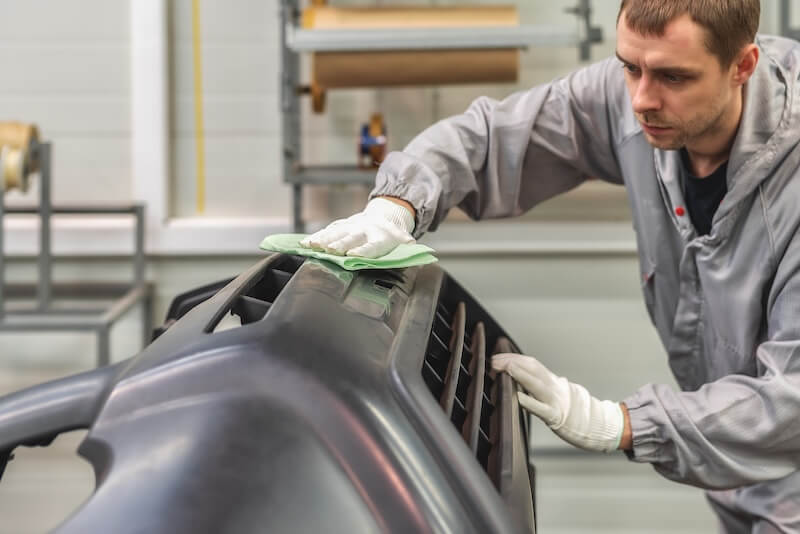There’s nothing worse than that moment when you hear the crunch. Whether it was a low-speed parking lot bump or an icy slide into a snowbank, your bumper takes the hit. Most drivers assume that once a bumper cracks or splits, it has to be replaced—and that can be costly. But there’s a better way, and at OHS Body Shop, we use it every day. It’s called plastic welding, and it’s one of the smartest, most sustainable ways to fix bumper damage.
If you’ve never heard of plastic welding, you’re not alone. Most people don’t realize that many modern bumpers—especially on today’s cars, trucks, and SUVs—are made of thermoplastic materials that can actually be repaired instead of thrown away. In fact, most cracked or split bumpers can be restored to full strength and a factory-finish appearance without needing full replacement.
Let’s break it down: what plastic welding is, how it works, and why it’s often the best option for Montana drivers dealing with minor to moderate bumper damage.
What Is Plastic Welding?
Plastic welding is exactly what it sounds like: it’s a method of repairing cracked or broken plastic components by using heat to fuse the material back together. Instead of gluing or patching, we use a plastic welder that melts the bumper’s plastic at a controlled temperature, allowing it to bond seamlessly—just like a metal weld. We often reinforce the repair from the backside with a mesh for added strength, then finish the surface to a smooth, paint-ready finish.
Unlike quick DIY fixes or cosmetic fillers, this process restores the original strength and structure of the bumper. It’s not a band-aid—it’s a long-term repair that’s strong, safe, and seamless.
Why Plastic Welding Makes Sense
First and foremost, it’s cost-effective. A brand-new bumper can cost hundreds—or even thousands—of dollars depending on your vehicle make and model. Add in painting, labor, and possibly sensor recalibration, and the bill climbs quickly. Plastic welding, on the other hand, is often a fraction of the cost. You’re paying for skilled labor and materials, not for a whole new part.
It’s also faster. No need to wait days or weeks for a new bumper to be ordered and shipped. We can often complete a plastic weld repair in less time, getting you back on the road sooner.
And of course, it’s environmentally friendly. When we repair instead of replace, we keep large plastic parts out of landfills. With thousands of bumpers being discarded each year, every repair we make instead of replacing makes a real impact. If you care about sustainability—and let’s be honest, most Montanans do—this repair method aligns with that value.
Will It Look the Same?
Yes, if it’s done by the right shop. At OHS Body Shop, we treat plastic weld repairs with the same attention to detail as any other collision work. Once the weld is complete, we sand and sculpt the surface to match the original contours perfectly. Then, we repaint and clear coat the area using manufacturer-matched paint so your bumper blends in flawlessly with the rest of your vehicle.
You’d never know it was cracked. And that’s the point.
Is It as Strong as a New Bumper?
In most cases, yes. As long as the damage is within repairable limits (more on that in a second), plastic welding restores the bumper to near-original strength. We often reinforce the weld from the inside using a special mesh material to increase durability. Once it’s finished, the bumper performs just as well as it did before the damage—both in looks and function.
We wouldn’t use the method if it wasn’t safe. Safety is always our top priority, and we’ll never recommend a repair we don’t fully stand behind.
When Is Plastic Welding Not a Good Option?
There are some cases where replacement is the better choice. If the bumper is completely shattered, has multiple deep punctures, or if internal mounts and brackets are broken beyond repair, replacement might be the safer and more practical route. Likewise, if there are embedded sensors or ADAS components that were damaged, we may recommend replacement to ensure those systems function correctly.
But the truth is, most everyday cracks, splits, and low-speed impact damage can be repaired with plastic welding—and it saves you time, money, and waste.
Why It’s Great for Montana Drivers
In Montana, bumper damage is a common issue. Between icy roads, gravel shoulders, wildlife encounters, and rural terrain, it’s not hard to end up with a cracked bumper. Plastic welding gives our customers a dependable repair option that’s both affordable and fast—something every driver appreciates when winter’s not done with the roads just yet.
We’ve repaired everything from small cosmetic splits to larger cracks caused by light deer strikes or curb impacts. And in many cases, our customers are amazed when they pick up their vehicle and see no sign of the damage they brought in.
Final Thoughts
Plastic welding isn’t just a clever fix—it’s a smart, sustainable repair method that more drivers should know about. At OHS Body Shop, we believe in giving our Montana neighbors real options when it comes to vehicle repair. If you’ve got a cracked bumper, bring it in for an evaluation. We’ll let you know whether plastic welding is the right fit, walk you through the process, and give you a clear, honest estimate.
We’re here to help you save money, avoid unnecessary waste, and get back on the road with confidence—because in Montana, we all need our vehicles in top shape.

